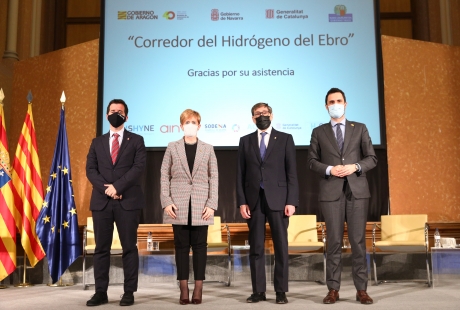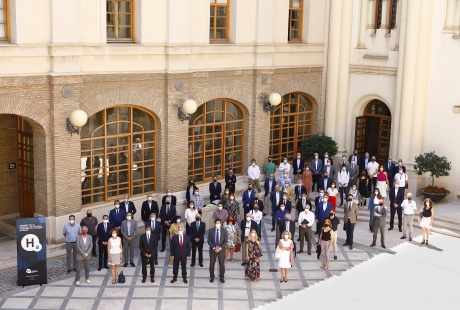Aragon has been the setting chosen to present the Ebro Hydrogen Corridor, a project that seeks to boost inter-territorial connection and serve as a link between the major regional initiatives around renewable hydrogen that are already underway in northeastern Spain.
This new ecosystem is set to play a leading role in decarbonising the surrounding industry while improving its competitiveness and attracting new investment. The project is supported by the Basque Hydrogen Corridor Association (BH2C), by ACCIÓ-Agency for Business Competitiveness as the entity responsible for the Hydrogen Valley of Catalonia (H2ValleyCat), the Foundation for the Development of New Hydrogen Technologies in Aragon (Fundación Hidrógeno Aragón) as the entity responsible for the coordination of the Aragon Hydrogen Valley “GetHyGA Initiative”, and the Industry Association of Navarra (AIN) together with the Society for the Development of Navarra (SODENA) as promoters of the Navarra Green Hydrogen Agenda.
Its creation, motivated by the desire to share information, analyse and study complementary actions that establish synergies between the different regional initiatives, has been driven by SHYNE, Spain’s largest multi-sectoral consortium for renewable hydrogen, launched last January, and which plays a fundamental role as a country project due to its integrating effect. SHYNE will also provide support for the projects developed in this initiative, knowledge management capacity and will promote research into pioneering technologies with the aim of positioning Spain at the forefront of this energy vector.
The presentation ceremony took place at the headquarters of the Government of Aragon and was attended by the Third Vice-President and Minister for Ecological Transition and the Demographic Challenge, Teresa Ribera, who explained that Spain will be at the centre of hydrogen production and will export hydrogen. She stressed that “the hydrogen economy is here to stay and the commitment of territories, companies and industries such as yours, which are providing critical solutions, to the point of being able to produce up to 70 or 80% of what we need to produce hydrogen in our country, we know that it is decisive and shows the way forward. That is why, from the Government, we have included a special role for hydrogen in the PERTE dedicated to renewable energies, storage and green hydrogen. Adding up, having corridors that allow us to combine the Hydrogen Valleys, industrial capacity and these end uses to test, expand and grow are absolutely crucial”.
The event began with words from the Director General of Industry and SMEs of the Government of Aragon and Vice President of the Aragon Hydrogen Foundation, Javier Navarro, and the CEO of Repsol, Josu Jon Imaz, who attended representing the presidency of SHYNE. Also in attendance were the President of BH2C, Jose Ignacio Zudaire; the Director General of Industry of the Government of Catalonia and CEO of ACCIÓ- Agency for Business Competitiveness, Natalia Más; the Managing Director of the Aragon Hydrogen Foundation, Fernando Palacín; the Director General of Industry, Energy and Strategic Projects of the Government of Navarra, Uxue Itoiz; the Director General of the Industry Association of Navarra, Ana Ursúa; and the Director of Hydrogen Repsol and President of SHYNE, Tomás Malango. They all highlighted the importance of this project as the backbone of the new hydrogen economy in this area, which will contribute to the generation of quality employment, the attraction of new investments and innovation in renewable hydrogen technologies, creating wealth throughout its area of influence.
Subsequently, the Minister of Economic Development, Sustainability and Environment of the Basque Government, Arantxa Tapia, the Minister of Business and Employment of the Government of Catalonia, Roger Torrent, the Vice President and Minister of Industry, Competitiveness and Business Development of the Government of Aragon, Arturo Aliaga, and the Minister of Economic and Business Development of the Government of Navarre and President of SODENA, Mikel Irujo, signed a public manifesto of cooperation and support for this initiative.
The Ebro Hydrogen Corridor will promote actions in all areas, including production, transport, use and storage. In terms of renewable hydrogen production, this ecosystem has set itself the ambition of installing a production capacity of 400 MW in 2025 (which entails 1.5 GW of associated renewable generation), and reaching 1.5 GW in 2030 (6 GW of renewable).
Another of its key lines of action will focus on stimulating the end uses of renewable hydrogen, both in the transport sector and in industrial uses in different sectors. Of note among these uses is the objective of achieving an annual production of 250,000 tonnes of products derived from renewable hydrogen such as methanol, ammonia or synthetic fuels by 2030. It will also promote the creation of a network of 20 hydrogen plants by 2025, an infrastructure that will have up to 100 points by 2030, to enable the deployment of its use in land, maritime and rail transport.
In addition, as regards the storage and transport of renewable hydrogen, cross-border projects will be promoted with the south of France to favour interconnection with Europe and position Spain as a relevant producer in the continental hydrogen market. This will be carried out in coordination with the Pyrenees Working Community.
Renewable hydrogen is one of the main energy vectors for achieving the decarbonisation of the economy thanks mainly to its versatility. Hydrogen is already used in the industrial sector as a feedstock in refining, in ammonia production, in the steel industry and mainly in the chemical industry. All these products will have a lower carbon footprint thanks to renewable hydrogen. But this gas also has multiple other uses; it is itself a clean fuel, in mobility it is used in the production of synthetic fuels or in fuel cells, and it can also be used to store renewable energy, thus solving the intermittency of wind and solar photovoltaic production. Coordination between all regional initiatives is a key element to achieve an efficient deployment of the hydrogen economy and to reach national and European targets.
The SHYNE project, under the leadership of Repsol, aims to promote inter-territorial actions and renewable hydrogen projects in all areas of the Spanish economy to promote rapid decarbonisation. SHYNE will deploy projects in ten autonomous communities and will have a total investment of 3,230 million euros that will serve to develop more competitive technologies and evolve both Spanish industry and its infrastructures towards decarbonisation, generating more than 13,000 jobs.
Statements
– The Vice President and Minister of Industry, Competitiveness and Business Development of the Government of Aragon, Arturo Aliaga: “Aragon already applied the approach behind the Ebro Hydrogen Corridor when it developed its own hydrogen valley, because we have always thought that no region will have the heritage of the entire value chain of this technology, which requires cooperation between complementary territories and actors. Our community offers unbeatable conditions for the implementation of such initiatives and the attraction of investment associated with them, such as a large green hydrogen production capacity, industry, skilled employment and the knowledge that comes from being pioneers in this field for two decades”. Aliaga concluded by assuring that “today we are laying the foundations for achieving industrial and energy sovereignty because we believe in the capacity of Spanish industry and the public administrations are aware that we cannot let this train pass us by”.
– The Basque Councillor for Economic Development, Sustainability and the Environment, Arantxa Tapia: “The Basque Hydrogen Corridor has taken on great relevance in the context of the current energy emergency. The creation of a hydrogen ecosystem, based in the Basque Country, which allows progress to be made in the decarbonisation of the energy, industrial, services and mobility sectors is more necessary than ever. The project opens up opportunities in the economic sphere, will involve an investment of more than 1,300 million euros up to 2026, and will generate more than 1,340 direct jobs and 6,700 indirect jobs. Above all, it will accelerate the energy transition and form part of the solution to energy needs. If all the territories join forces in the same direction, the achievements will be of great significance”.
– The Regional Minister for Economic and Business Development of the Government of Navarre and President of SODENA, Mikel Irujo: “The Ebro Hydrogen Corridor makes us more competitive, enabling us to strengthen the hydrogen value chain, gaining in size and scope to take on projects that we could not do alone, and to look to Europe. This public-private collaboration model will make it possible to develop an industry based on this energy vector”.
– The CEO of Repsol, Josu Jon Imaz, the entity that holds the presidency of SHYNE: “Due to its location, the Ebro Hydrogen Corridor will be a key lever to effectively develop all the potential of this geographical area, with a cross-border dimension of the future hydrogen economy, allowing a greater integration of value chains at European level”.


